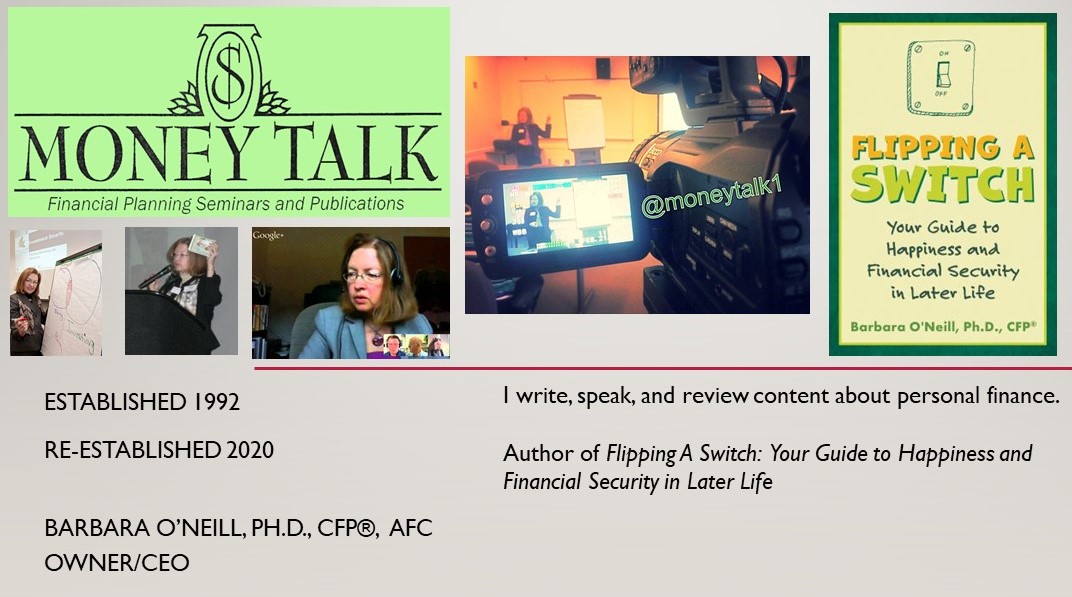Budgeting is a fundamental financial
planning practice. Without a budget, it is hard to manage other aspects of
personal finance including credit, insurance, saving, investing, and achieving
goals such as a new car or a comfortable retirement. Financial goals cannot be reached
if there is no money set aside for them.
Budgeting has also been found in research to be
associated with performance of positive health and financial practices. People
who budget their money may be inclined to “budget” their calories and self-restrict
their food consumption and/or adjust their physical activity to stay within
their daily calorie “allowance.”
Below are ten things to know about
budgeting:
¨ Positive Cash Flow is the Goal- A budget is a plan for future income and
expenses, including savings. The goal is positive cash flow, i.e., income
greater than savings. Ideally, a budget should be hand-written or
computer-generated with specific categories of income, spending, and dollar
amounts.
¨ Individual Factors are Important- Examples include individual needs and
wants, whether you have a stable income (the same amount in each paycheck) or a
variable income that fluctuates every month, and whether you prefer to use a
“paper and pencil” worksheet, an Excel spreadsheet, or a budgeting app.
¨ Savings is a Fixed Expense- How much you need to save per month or
per paycheck to fund future goals should be set aside as a fixed expense that
stays the same from month to month in a budget. A general online financial
goal-setting calculator can determine the correct amount to save. There
are also specialized calculators for specific financial goals such as
educational expenses and retirement.
¨ Budgeting Methods Vary- Many people use the same budget format
from year to year, adjusting for changes in income and expenses. For example,
twice a year, I project income and expenses for the next six months and work in
irregular income and expenses. What matters most is that you have a
budget, not how you budget.
¨ COVID-19 Impacted Budget Priorities- Many people are working less (or not at
all) and are struggling to make ends meet. Others have earned as much or more
than they did pre-COVID-19 and/or are saving more money due to decreased
spending. Not surprisingly, there is increased interest in beefing up emergency
funds.
¨ Unexpected Expenses Always Occur- It is not a question of “if,” but “when,”
unexpected expenses happen. For this reason, financial experts recommend
including a “fudge factor” dollar amount (a.k.a., a “miscellaneous budget category)
in household budgets. If the money is not needed, it can be rolled over into
savings.
¨ Expenses Can be Trimmed- Experts recommend starting with flexible expenses
such as heating/cooling, subscriptions, streaming fees, food, and memberships.
Also, look for less expensive shopping options (e.g., thrift shops), do more
cooking at home, and consider ways to reduce fixed expenses such refinancing a
home mortgage, selecting a less expensive apartment or car, and shopping around
for insurance policy discounts.
¨ Income May Be Able to Increase- Options include increasing human capital
through degree and certification programs, “leaning in” (i.e., asserting
oneself professionally) to get promoted, and/or starting a “side hustle” or
getting a second job as long as it does not violate your primary employer’s
outside employment rules.
¨ Benefits Can Supplement Income- People who are struggling financially can
receive public benefits (e.g., utility assistance or food from a food bank), if
income qualified. This frees up income for other expenses. Other ways to
increase income are to barter goods and services in lieu of spending cash and
to sell unneeded items.
¨ Budgets Affect Credit Scores- A budget can prevent negative credit
report data by including funds to repay debt as a fixed expense. Also, if
followed, a budget can help avoid overspending on credit, which reduces a
credit cardholders’ credit utilization ratio, worth about 30% of a FICO credit score.
Finally, a budget can include funds to build an emergency fund so people are
less likely to use credit in emergencies.
To start
creating your own personal budget, track your income and expenses for a month
or two to get accurate data and use this Spending Plan Worksheet from Rutgers Cooperative Extension.




